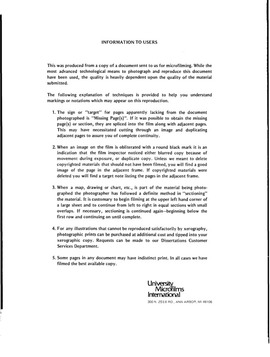| dc.contributor.author | Moon, Soo-young, | en_US |
| dc.date.accessioned | 2013-08-16T12:28:30Z | |
| dc.date.available | 2013-08-16T12:28:30Z | |
| dc.date.issued | 1982 | en_US |
| dc.identifier.uri | https://hdl.handle.net/11244/4957 | |
| dc.description.abstract | In the confirmation process, four separate steps are taken. The reduced model based on six variables is utilized to find whether this model is consistent over three years, 1976, 1977 and 1978 in terms of R('2), bi value, signs of variables and the number of significant variables. Besides this rule of thumb, a more objective analysis is adopted to determine if the data of three years can be pooled with respect to intercepts and slopes. Another confirmation process is the analysis of the mean square error. The last confirmation process involves a comparison of predicted labor productivity with actual labor productivity. Overall the empirical results support the model. | en_US |
| dc.description.abstract | After this study limits its scope to labor productivity in the retail hardware industry at the micro level, the developed productivity model is tested empirically. The main characteristic of this model is that productivity can be explained by three blocks of endogenous variables, decision making variables, business health and organizational structure. | en_US |
| dc.description.abstract | The searching process involves testing 15 hypotheses based on data from 1976. The test results show that out of 15 hypotheses, only six hypotheses can be accepted. They are: scale, wages, two service levels and two promotional variables. | en_US |
| dc.description.abstract | The empirical parts of this study contain methodological considerations, a searching process of labor productivity determinants, and a confirmation process of identified determinants. Methodological considerations include the analysis of the functional relationship between labor productivity and its associated variables, the identification of the difference among different measures of input and output, and the examination of the existence of multicollinearity in the model. | en_US |
| dc.description.abstract | The purpose of this study is to answer the following questions: (1) What is productivity and why is it important at a micro level and a macro level? (2) How should productivity be measured? (3) What relation does productivity have with its explanatory variables? (4) What is the influence of marketing mix decision variables on productivity? (5) Can the developed productivity model be confirmed? | en_US |
| dc.format.extent | x, 157 leaves : | en_US |
| dc.subject | Business Administration, Marketing. | en_US |
| dc.title | Labor productivity : | en_US |
| dc.type | Thesis | en_US |
| dc.thesis.degree | Ph.D. | en_US |
| dc.thesis.degreeDiscipline | Michael F. Price College of Business | en_US |
| dc.note | Source: Dissertation Abstracts International, Volume: 43-03, Section: A, page: 0909. | en_US |
| ou.identifier | (UMI)AAI8215791 | en_US |
| ou.group | Michael F. Price College of Business | |
